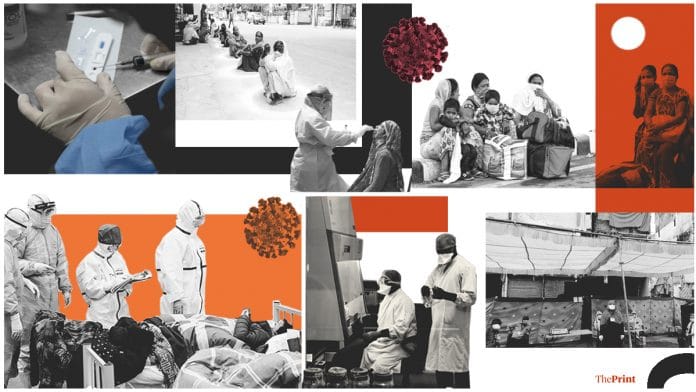Congress leader Rahul Gandhi Thursday joined a battery of health experts who have said that India’s testing rate was very low, urging the Modi government to increase it. The ICMR was quick to refute the claims arguing that “not everyone is vulnerable”. The health ministry also endorsed ICMR’s view, saying that data can be interpreted in many ways and the government is ensuring not a single positive case is missed out.
ThePrint asks: Does India need more Covid-19 testing or is it an uninformed argument?
Rethink strategy; prioritise Covid-19 testing for people at high risk
 Radha Rangarajan
Radha Rangarajan
Chief Scientific Officer, HealthCubed
There is a need for India to do more Covid-19 testing. So far, testing has been greatly restricted but as we emerge from the lockdown, there will be an increased need to test more and more people. It is amply clear that the current test — RT-PCR — will not scale for India’s needs, given the complexity of this test, need for sophisticated equipment and poor availability of kits. Hence, we need to rethink the testing strategy.
Specifically, we need to identify people at greatest risk, making no assumptions about community transmission, and prioritise them for the test. The data from China and other parts of the world identify a number of factors that put people at risk for this severe disease, including age, gender, comorbidities, biomarkers and specific blood parameters.
These data taken together with clinical signs and symptoms can provide an accurate assessment of risk relatively quickly. Those at moderate to high risk can be prioritised for testing and follow-up care. This type of screening system can scale easily and be deployed rapidly. Of course, we will still need to ramp up the production of the RT-PCR tests and enhance laboratory capacity but a tiered approach will help rationally narrow the funnel.
India doesn’t need to chase testing numbers of South Korea or Germany
 Dr. Ashok Seth
Dr. Ashok Seth
Chairman, Fortis Escorts Heart Institute
The real question is how much Covid-19 testing does India need and for what purpose? First, we don’t need to chase testing numbers of South Korea or Germany as ‘the gold standard’ because for our 1.3 billion population that would translate to more than one crore tests which strategically, financially and logistically could be a detrimental exercise.
Second, the lockdown has largely helped to contain the Covid-19 infection. It’s not only helped utilise our limited testing resources judiciously but also preserved and even expanded them for now when more testing is needed .
Third. The tests are not foolproof and expanding testing when disease prevalence is low in community gives increased number of false positives which can overburden the healthcare system unnecessarily.
As we plan towards a graded lifting of the lockdown along with the availability of rapid testing and indigenously-manufactured kits, performing more random, suspect and pooled testing in communities would help more accurately map the prevalence of Covid-19. This can lead to better containment measures.
India has ramped up its testing in the last 10 days and the increase in new cases seems to be flattening as a percentage of tested or total cases. I can confidently state that these numbers seem to be correct and the situation still remains under control. So clearly, unlike the West, a strategy of pre-emptive and strict lockdown with limited testing, followed now by an increased testing to strategise release of lockdown seems to be working in India.
Besides ‘public health testing’, India must ramp up ‘healthcare testing’ to prevent hospitals from becoming Covid-19 hotspots
 Dr. T Jacob John
Dr. T Jacob John
Former head, ICMR in Virology
India needs more Covid-19 testing. Our population-based testing average is one of the lowest among affected countries. It has been argued that we have the slowest increase in the number of positive Covid-19 cases. But the problem is that if you test less, you will detect less. Since we do not know the true infection prevalence, this line of argument takes us nowhere.
The strike rate in India is one positive among 24 tested, whereas in other countries the rate is higher — such as one Covid positive per 12 or even 10 tests. This means that our strategy must be fine-tuned to look at areas where the detection rate is better. Currently, the emphasis is on finding contacts of those with travel-associated risks and contacts of infected persons detected so far. The purpose is to quarantine and protect the uninfected. That is “public health testing”. And so the strike rate is low.
As we detect more and more positive Covid-19 cases, we will know that transmission is slipping through the public health testing net; hence we must ramp up “healthcare testing” and prevent transmission among healthcare personnel and their contacts.
Healthcare testing will help prevent hospitals from becoming hotspots. Every clinically suspected Covid-19 case confirmed by lab test will also achieve the public health goal of preventing further transmission more efficiently. Then the strike rate will also be higher.
The assertion that India has a shortage of testing kits is untrue
 Indranil Mukhopadhyay
Indranil Mukhopadhyay
Associate Professor, OP Jindal Global University and member, Jan Swasthya Abhiyan
Overall there are fewer Covid-19 tests being conducted than required. According to ICMR’s revised guidelines, clusters, containment zones or places with large migrant population are vulnerable to the coronavirus and people with influenza-type symptoms should be tested with rapid antibody tests. All those who are under isolation should be tested.
Another factor is that rapid antibody tests sometimes produce false negatives, which means a person may not show positive results but is infected. In this case, a test must be repeated in 5-10 days. For people who continue to experience influenza-type symptoms during self-quarantine, RT-PCR test must be done. This shows that testing is not always quick and easy – cases require various degrees of testing, resources and time.
Also, the assertion that India has a shortage of testing kits is untrue. Lakhs of rapid antibody test kits are available. National Institute of Cholera and Enteric Diseases has about 42,000 testing kits and works as the nodal-testing lab for eastern region but still, in those regions just a few thousand tests have been conducted. All severe acute respiratory infections (SARI) cases should be tested too.
Finally, a more structured and targeted strategy is required in India. Contact tracing, as done in Kerala, should also be considered during this exercise. All people in contact with positive cases should be tested and brought under isolation.
The lockdown is becoming a major humanitarian crisis. If we do not track all the cases, trace all the contacts, test and isolate them, the benefits of the lockdown would not fructify and the outbreak would take the form of an epidemic in India.
Also read: Is forcing private labs to make Covid-19 tests free the only way to stop spread of infection?
By Pia Krishnankutty, journalist at ThePrint







This whole rebuttle from the ICMR states how we are incapable of testing. We have not even tested 3% of our population yet. The numbers speak for themselves.
How to balance the needs of the economy and society with the goal of keeping people healthy.
No one has been able to explain to me the value of “testing.” Can you? One can be tested one day and be found clear of the virus and come down with it the next day. How does that help anyone? Secondly, there’s no way I’m going in for testing which would put all my associates in quarantine for 14 days when they’ve already be “in place” for four weeks! This doesn’t make any sense to me.
Suggestion is the population to be divided into low- and high-risk groups.
1)People under the age of 65 and without underlying medical conditions
2) One’s who are at low risk for becoming fatally infected with corona, can return to life as usual while following certain distancing protocols. Admitted how well will this work and how to be implemented/enforced to be worked out
Those over 65 or with co-morbidities, who are high-risk, would stay at home and be surgically quarantined – tested as soon as they exhibit coronavirus symptoms. If people test positive, they are quarantined, epidemiological tracking is carried out and all those who they were in contact with are also isolated. The high-risk population will gradually be released.
The strategy of complete or large scale lock down is in effect at this time. Its logic is to drastically limit new cases of the virus, and give time for the infected to recover or not. The virus will have fewer and fewer hosts and eventually won’t exist.
Lock down businesses to be shut down, and people to be unemployed. Given sufficient time, the country goes bankrupt, and lives are ruined. This follows the saying “The cure is worse than the disease”. A different “cure” is required, which is one that allows the economy to function to a degree, while keeping deaths to a minimum.
There are two issues: the time period when the virus exists and infects people, and the time to recover or not. Without a cure, the time line of recovery or death for COVID-19 does not change, no matter what. The first issue can be controlled, and would allow new cases and deaths to be kept to a minimum, while allowing the economy to function to a degree.
The goal is to shorten the times when people can get infected and the economy gets back to running at full steam. They all require the same thing, which is to allow people to get infected in a managed way. They create different balances between the total number of cases (and the length of time for the virus to disappear), and running a viable economy while the virus exists.
All the people (including WHO) who are arguing about lower testing are not uninformed .
an uninformed argument? Sheesh
I do not understand the reluctance to test more widely. Even in Bombay, one of the most affected spots in the country, and amongst the relatives and close contacts of those who have been infected. For fifteen prominent hospitals in Bombay to be closed because so many of their healthcare professionals are infected weakens the overall capacity to fight the pandemic. More testing would give us a better understanding of the spread of the virus and plan the gradual lifting of the lockdown more scientifically. Nor is any useful purpose being served by reiterating the assertion that the stage of community spread has not been reached. Tell it like it is, as Governor Andrew Cuomo is doing.